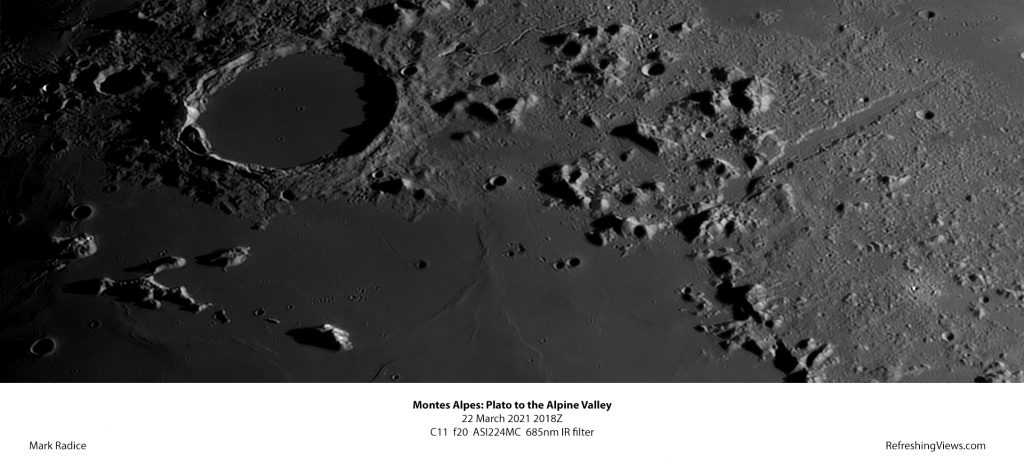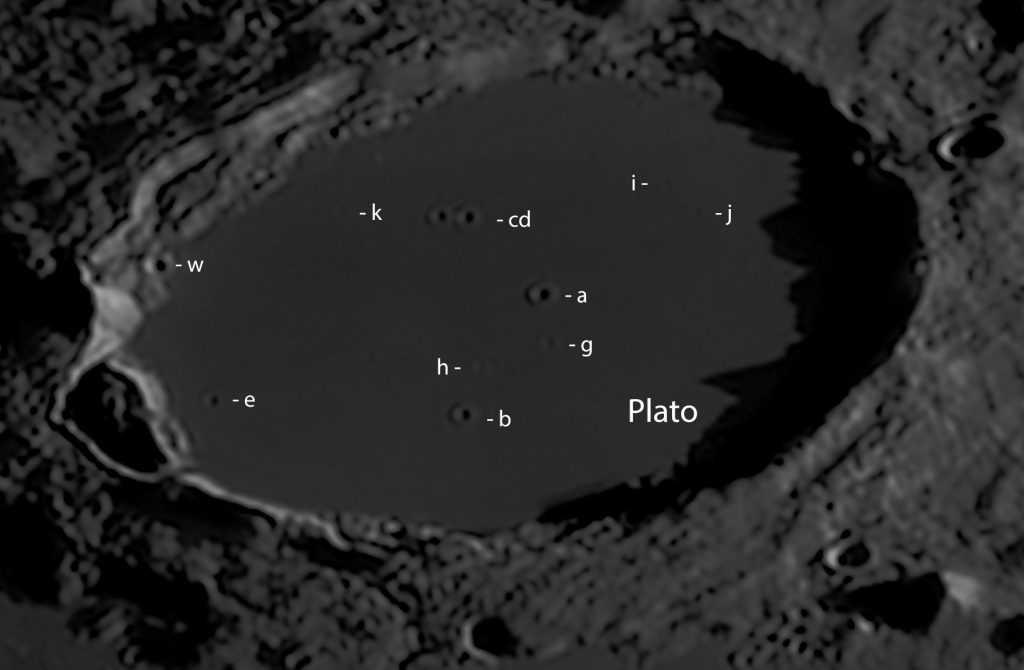22 March 2021: Exploring the Montes Alpes Region
The image below (a mosaic of 2 frames) shows the Montes Alpes region from Plato to the nearby Vallis Alpes as seen on 22 March 2021. While adding labels and making it presentable, a number of interesting features worthy of further discussion were noted.

The crater Plato (101km) on the northern shore of Mare Imbrium is a beautiful crater full of contrasts. Plato’s dark interior aids identification as it stands out against the brighter background of the surrounding Montes Alpes, particularly near first and last quarter. Its dark, flat floor, large enough to be readily seen in binoculars and finderscopes, is a symptom of the lava flooding that occurred after its formation as the Imbrium impact basin was slowly covered in lava. Note that there is no central mountain peak so it too is long buried.
Plato’s rim towers some 1.5-2km over the flat floor casting dramatic shark-toothed shadow formations at sunrise and sunset. Of note, there is a huge, detached section on the western rim that appears to have slipped away.
To the south are the isolated peaks of Montes Tenerife that are the peaks of the Imbrium impact basin now surrounded by a sea of frozen lava. The tallest of these, Mons Pico (2.5km) is particularly bright appearing as a bright spot against the dark basalts. Likewise, these peaks cast dramatic shadows across the flat surface.
Alongside Pico is a ghost crater of the same diameter as Plato, informally known as Ancient Newton (to avoid confusion with the Newton crater in the southern hemisphere) whose tenuous outline only appears under low solar illumination. It is made up of the eastern edge of Montes Tenerife, Mons Pico itself and a wrinkle ridge left in the lava. It is strange to think of all these features now frozen under repeated eruptions of volcanic lava.
Alongside Plato are a number of rilles that are the left over river beds that had been filled by flowing lava, presumably from the same geological event that filled Plato. The larger rille, to the north east, appears to have the same crater-like vent as seen at Schroter’s valley near Aristarchus.
At first glance, Plato’s crater floor appears devoid of detail. On inspection, however, there are a number of smaller craterlets around a mile or so in diameter that can be glimpsed under good seeing and with suitable solar illumination. What appears to be a featureless crater floor is actually filled with challenging craterlets at the limit of resolution.
Magnifying the image and, referencing the Times Lunar Atlas and an article by David Knisely on Cloudy Nights, reveals a number of craters that are visible to the keen observer.
- There are “the big four” craters a (2.7km), b (2.4km), and the pairing of c (2.4km) and d (2.1km). The crater rims and shadowed-floors are clearly visible in the image.
- On the western wall is a larger pit, w (3.2km).
- Smaller in size are the craterlets e (1.9km), g (1.5km) and the elongated craterlet pair h (1.3km). Craterlet f was not seen as it is hidden under the shadows cast by the crater rim.
- Higher magnification is required to detect the dark markings of i (1.2km), j (1.0km) and k (1.3km).
- There are a number of smaller craters but these are not seen even under further enlargement.
- By inspection, therefore, my C11 under good seeing can readily resolve lunar features of around 1 mile and, with image magnification, identify features of 1km.
Further east is the Montes Alpes. Bisecting this is the Alpine Valley a geological fault that flows 166km from Mare Imbrium to Mare Frigoris with a maximum width of 10km. On the floor, is a narrow rille that is also just visible – especially when it is partially filled with a shadow that contrasts with the brighter surroundings. At the southern end, nearer Mare Imbrium is what appears to be a small crater chain with a nominal diameter of 1.8km whereas the rille itself has a nominal width of around 0.6km. It is interesting to note that this is much less than the smallest craters detected in nearby Plato.
Clearly this is an interesting and geologically diverse region.
